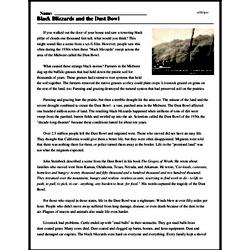Black Blizzards and the Dust Bowl
If you walked out the door of your house and saw a towering black pillar of clouds one thousand feet tall, what would you think? This might sound like a scene from a sci-fi film. However, people saw this often during the 1930s when these "black blizzards" swept across the area of the Midwest called the Dust Bowl.
What caused these strange black storms? Farmers in the Midwest dug up the buffalo grasses that had held down the prairie soil for thousands of years. These grasses had extensive root systems that held the soil together. The farmers removed the native grasses so they could plant crops. Livestock grazed on grass on the rest of the land, too. Farming and grazing destroyed the natural system that had preserved soil on the prairies.
Farming and grazing hurt the prairie, but then a terrible drought hit the area too. The misuse of the land and the severe drought combined to create the Dust Bowl - a vast, parched area in the Midwest. The Dust Bowl affected one hundred million acres of land. The resulting black blizzards happened when millions of tons of dirt were swept from the parched, barren fields and swirled up into the air. Scientists called the Dust Bowl of the 1930s the "decade-long disaster" because these conditions lasted for about ten years.




